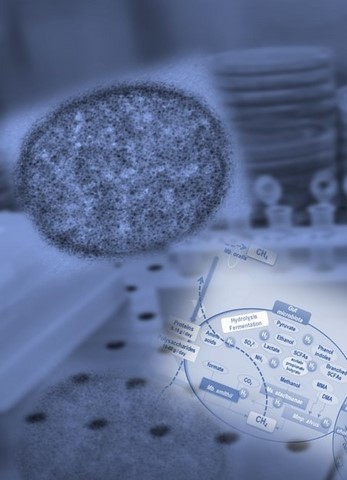Methanogenesis

Each part of living beings and even organism groups have varying metabolic characteristics. However, there is one metabolism which is very particular, METHANOGENESIS. This is only found among archaea, and not all ... thus that some of archaea are called methanogenic archaea or even shorter, methanogens. Let's understand the words: methanogenesis literally means "methane production". Some organisms other than archaea produce methane by their metabolism BUT this methane is a secondary product. Methanogenesis in the sense used by biologists relies upon the notion of an essential / mandatory metabolism, because ultimately allowing the generation of ATP (living energy storage molecule). Methane is ultimately only a kind of "waste" of a pathway for electron transfer. We will see a little further how this can work.

Methanogens participate in the carbon cycle in nature, ie the different forms in which carbon atoms are found in nature. These forms change, being (bio)transformed inotably by the different living organisms.
- Methane is a powerful greenhouse gas (GHG), more than 20 times stronger than the effect of CO2. Although it is not the only source of methane in the atmosphere, this gas is produced on a large scale naturally by methanogenic archaea that live in different natural environments. Among these environments, we must not forget the gastrointestinal tract of many animals including ... termites and also ruminants, whose human exploitation of herds are currently increasing, and thus increasing the production of methane. Finding ways to limit the presence of these methanogenic archaea and their methanogenic activity are therefore important in the context of global warming of our planet.
- Conversely, producing methane by biological ways can also be a solution with rarefaction of fossil fuels, with multiple benefits: Reduction / recycling of organic waste generating carbon dioxide, a greenhouse gas, that can be further converted by methane archaea into methane... that can be in turn used as an energy source by humans. Thus we see "methanizers", especially in farms, to heat them, etc ..., as generators of biomethane.
- Also, we suspect this metabolism to be an ancient one, one of the firsts that appeared on earth (or... elsewhere): it must be performed in the absence of Oxygen O2, as was the case in the primitive conditions of life, and for some organisms, this is made from very simple compounds such as carbon dioxide CO2 and H2. Understanding these metabolic pathways and their origins in these organisms can help in better understanding of a supposedly ancestral metabolism, therefore addressing the question of the origins and evolutions of the living.
How these organisms do synthesize methane?

- Methane is made from different "substrates" among archaea, and by different ways: simply speacking, we can define 3 major modalities. Until recently (including our work published in 2012-2013), we imagined that methanogens were all capable of using CO2 and hydrogen H2. When hydrogen is used as an electron donor, organisms are hydrogenotrophs, thus leading to a pathway entitled hydrogenotropic methanogenesis. There were few exceptions to this mode of methanogenesis (in blue opposite), so that this kind of methanogenesis was considered the oldest way invented by the living. A few rare species, affiliated with each other and grouped together in a single methanogenic ORDER, can also use Acetate, a molecule with 2 carbons, which is in a caricatured way, like having 1 carbon in the form of CO2 (previous case) and the other one which becomes "directly" methane. We speak of acetotrophic methanogenesis, but more clearly of aceticlastic methanogenesis, showing well the "disruption into to molecules" ("clast") of acetate. Finally, other methanogens (also "rare" and present in a single order of archaea) can also abstain from the presence of H2 and directly use simple "methylated" compounds (C1-compounds), such as methanol or methylamines (in green on the figure). They are called methylotrophs performing a methylotrophic methanogenesis. A part of the methylated compounds has to be used by the "hydrogenotrophic methanogenesis" reactions, in a reverse manner, to produce reducing euivalents used to reduce other C1-compounds. A derivative of this methanogenesis which needs H2, but in turn, that can work without the need of the hydrogenotrophic methanogenesis reactions is explained in the subchapter methanogens and intestinal microbiota as well as in the chapter devoted to health with archaebiotics.
works, article in 2008). Finally, this 7th methanogenic order (now called Methanomassiliicoccales) had the originality of not having any of the genes to achieve a hydrogenotrophic methanogenesis (from CO2 and H2). This does not prevent it from depending on H2 as an electron donnor (by definition, thus being hydrogenotrophs) while achieving the equivalent of a methylotrophic methanogenesis ....... Our metabolic classification of methanogenesis deserves to be review in light of these newly discovered organisms.
